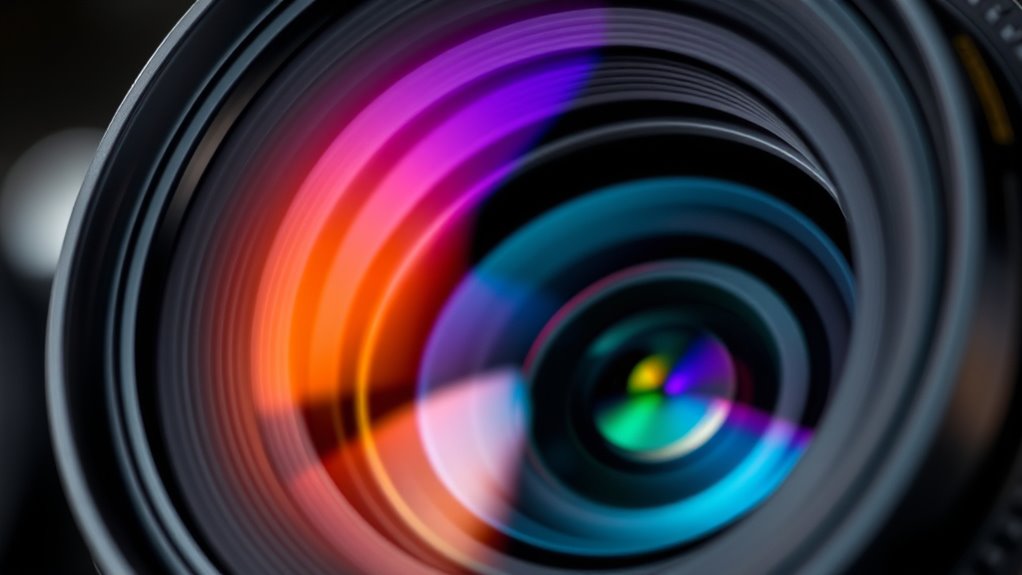Dynamic iris technology adjusts the aperture in your camera automatically, controlling how much light enters for ideal exposure. It constantly reacts to changing lighting conditions by opening or closing aperture blades, ensuring accurate color reproduction and image clarity. This system improves contrast, reduces overexposure, and maintains consistent brightness, making your photos and videos look natural. Understanding how this advanced feature works can help you capture better images. Keep exploring to learn more about its benefits and applications.
Key Takeaways
- Dynamic iris technology uses mechanical aperture adjustments to regulate light entry, ensuring optimal exposure and vibrant color accuracy.
- It responds in real-time to changing scene brightness, maintaining consistent color saturation and preventing overexposure.
- By adjusting aperture blades smoothly, it helps preserve true colors and contrast across varying lighting conditions.
- Integration with sensors and algorithms allows the system to analyze ambient light and automatically optimize color rendering.
- Lens coatings and calibration enhance the dynamic iris’s ability to reduce glare and color distortion, supporting precise color control.
What Is Dynamic Iris Technology?
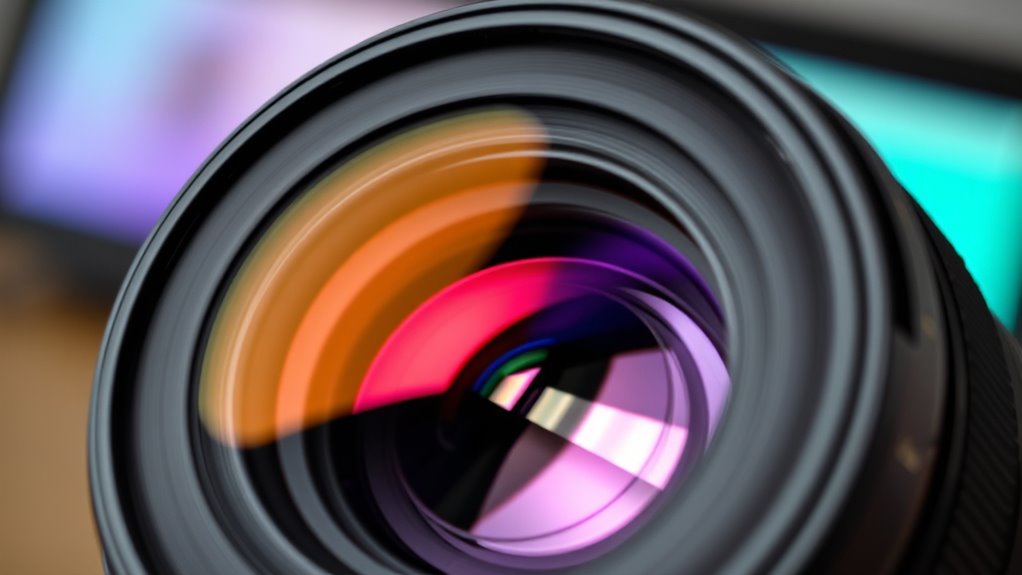
Have you ever wondered how modern cameras can automatically adjust to changing light conditions? That’s where dynamic iris technology comes in. It relies on iris mechanics to control the aperture, which is the opening that regulates light entering the lens. Unlike fixed aperture systems, dynamic iris technology constantly adjusts the aperture size in real-time, based on the scene’s brightness. This precise aperture control guarantees ideal exposure, preventing overexposure in bright light and underexposure in low light. The system uses sensors and algorithms to analyze the incoming light and make rapid adjustments. This seamless process allows your camera to maintain clear images with balanced brightness, no matter how the lighting changes. Fundamentally, dynamic iris technology makes your camera smarter about light, improving overall image quality.
The Mechanics Behind Dynamic Iris Adjustment

At the core of dynamic iris technology are precise mechanical components that adjust the size of the aperture in real-time. This iris aperture changes shape smoothly to control the amount of light entering the camera, ensuring ideal exposure. When lighting conditions vary, sensors detect these changes and send signals to the iris mechanism. Using tiny motors and gears, the system quickly widens or narrows the aperture, modulating light precisely. This process allows for effective light modulation, preventing overexposure or underexposure. The mechanics behind this adjustment are designed for speed and accuracy, responding instantly to scene changes. As a result, your camera maintains consistent image quality regardless of lighting variations, giving you better control over brightness and contrast in every shot. Additionally, advancements in automation technologies contribute to the swift and accurate operation of dynamic iris systems.
Comparing Fixed Aperture and Dynamic Iris Systems
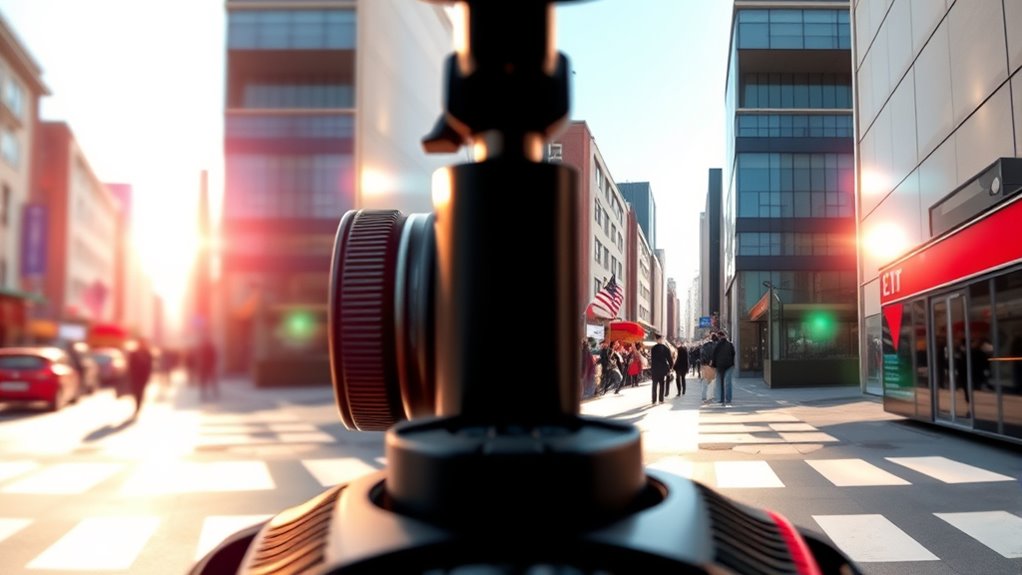
Fixed aperture and dynamic iris systems each serve different needs in camera technology. Fixed aperture cameras have a set opening, providing consistent exposure but limiting aperture flexibility. This requires precise iris calibration during setup to ensure ideal image quality across lighting conditions. In contrast, dynamic iris systems automatically adjust the aperture in real-time, allowing for greater adaptability to changing light. This enables better control over exposure and enhances image clarity. While fixed apertures are simpler and more reliable for static environments, dynamic iris systems excel in variable lighting scenarios, making adjustments seamlessly. Your choice depends on your specific needs—fixed aperture offers stability, whereas dynamic iris provides versatility through automatic iris calibration, maximizing image quality in diverse settings. Additionally, dynamic iris technology can help optimize contrast ratios, leading to deeper blacks and brighter highlights for a more vivid image.
How Dynamic Iris Enhances Color Accuracy
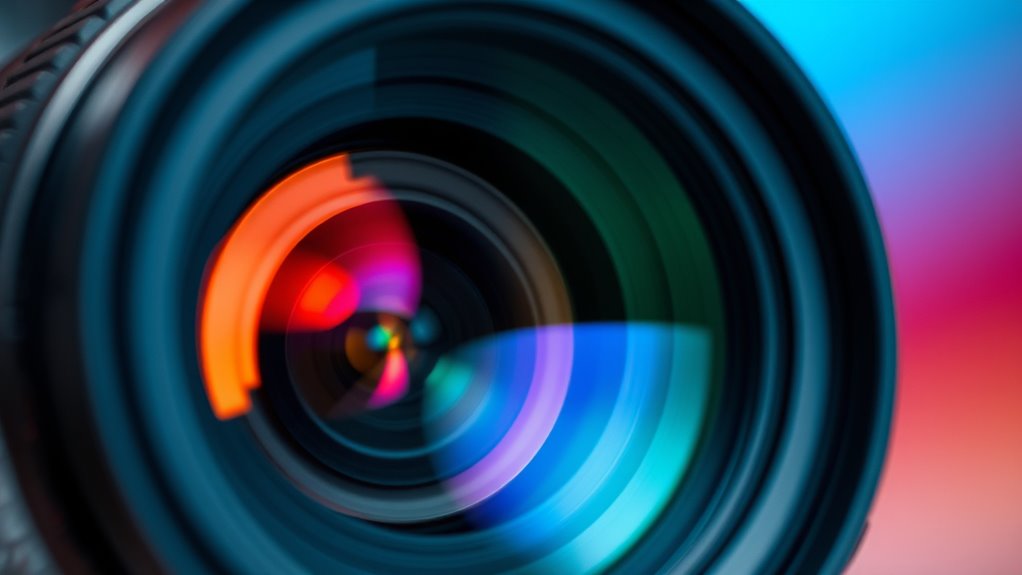
Ever wondered how dynamic iris technology improves color accuracy in your images? It adjusts the iris aperture in real-time, guaranteeing ideal light levels that preserve true colors. By fine-tuning the iris aperture, the system reduces exposure errors and prevents color distortion. This precise control enhances color precision, making hues appear more vibrant and true to life. Additionally, understanding pool terminology helps you recognize how proper lighting and aperture settings contribute to achieving optimal color fidelity.
- Maintains consistent lighting conditions for accurate color rendering
- Minimizes overexposure or underexposure that can skew colors
- Adapts swiftly to changing ambient light for stable color output
- Reduces color bleeding caused by improper aperture settings
- Ensures the camera captures the scene with natural, vivid colors
With dynamic iris technology, your images stay true to their original colors, offering exceptional color fidelity and clarity.
Impact of Dynamic Iris on Exposure Control

Dynamic iris technology markedly enhances exposure control by automatically adjusting the aperture in real-time to match changing lighting conditions. This precise control depends heavily on lens design, allowing the iris to respond swiftly without compromising image sharpness. As lighting fluctuates, the iris modifies its opening, maintaining ideal exposure levels. Sensor sensitivity also plays a vital role; cameras with higher sensitivity can better interpret light variations, enabling the iris to fine-tune exposure more effectively. By integrating these elements, your camera guarantees consistent image brightness, even in challenging lighting. The dynamic iris reduces the need for manual adjustments, helping you capture well-exposed footage seamlessly. Overall, this technology streamlines exposure management, resulting in clearer images with balanced light, regardless of environmental changes.
Benefits of Using Dynamic Iris in Different Lighting Conditions
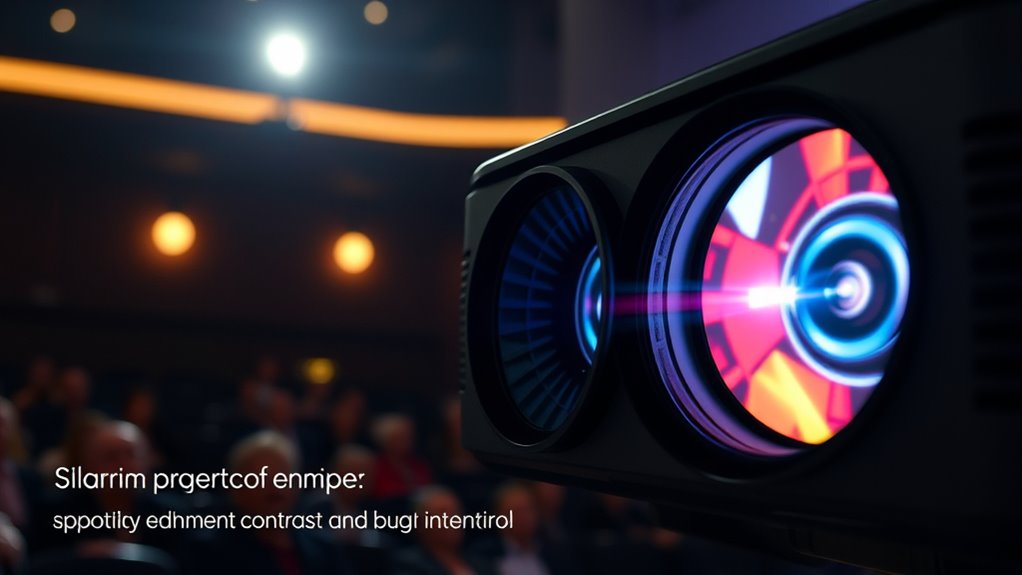
The ability of dynamic iris technology to adapt to various lighting conditions offers significant advantages in real-world shooting scenarios. By adjusting the iris shape in real-time, you can guarantee ideal exposure without sacrificing image quality. This flexibility helps you maintain consistent brightness, even when moving between bright sunlight and shaded areas. Additionally, advanced lens coatings reduce glare and flare, enhancing clarity in challenging light. The dynamic iris also minimizes the need for manual adjustments, saving time and preventing overexposure or underexposure. Overall, this technology improves your control over image quality across diverse lighting environments, making your shots more professional and visually appealing. Remote operation capabilities allow for even more precise adjustments in dynamic settings.
Integrating Dynamic Iris With Camera Settings
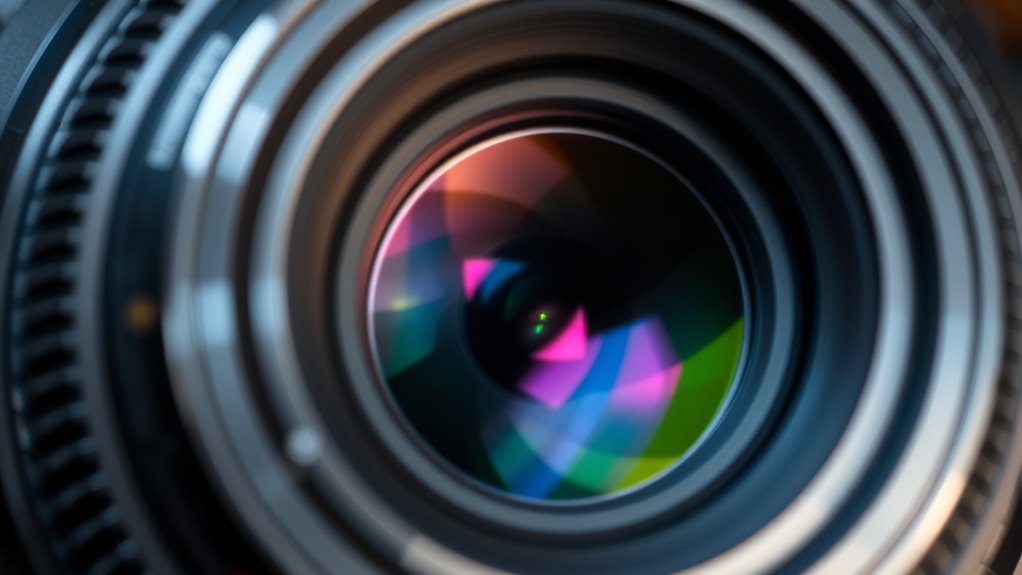
To get the most out of your camera, you need to synchronize the dynamic iris with your settings. This guarantees the iris adjusts smoothly as lighting changes, keeping your images clear and balanced. Adjusting these settings together makes your camera more responsive to varying lighting conditions. Embracing the attention you give to your camera’s settings can significantly enhance your creative control and image quality.
Synchronizing Iris & Settings
Integrating Dynamic Iris with camera settings requires precise synchronization to guarantee ideal image quality. Proper coordination ensures the iris operates smoothly within the aperture design, maintaining iris aesthetics and avoiding abrupt changes that could disrupt the shot. To achieve this, you should:
- Match iris response time with shutter speed for seamless adjustments
- Calibrate exposure settings to complement iris movements
- Use manual controls for consistent iris behavior during critical shots
- Adjust gain and ISO to reduce noise without overexposing
- Regularly review and fine-tune camera profiles to align iris performance with desired image characteristics
- Consider vetted products to ensure compatibility and optimal performance of your camera system
This synchronization minimizes flickering and ensures the dynamic iris enhances overall image quality, blending seamlessly with your camera’s settings for excellent results.
Adjusting for Lighting Variations
Adjusting camera settings to accommodate lighting variations is essential when working with a dynamic iris. To optimize performance, consider the lens coatings; high-quality coatings help reduce reflections and glare, ensuring accurate light control. When lighting changes, tweak the aperture blades to adjust the iris smoothly, maintaining proper exposure without abrupt shifts. A well-calibrated dynamic iris responds to these adjustments, balancing light intake effectively. Keep in mind that inconsistent lighting can cause the iris to rapidly open or close, so fine-tune camera settings to match the environment’s brightness. Using lenses with appropriate coatings also minimizes flare, allowing the iris to function precisely. Recognizing the role of the dynamic iris in adapting to changing lighting conditions helps in achieving consistent image quality. Ultimately, integrating these adjustments ensures consistent image quality, even amid fluctuating lighting conditions.
Practical Applications of Dynamic Iris in Photography and Videography
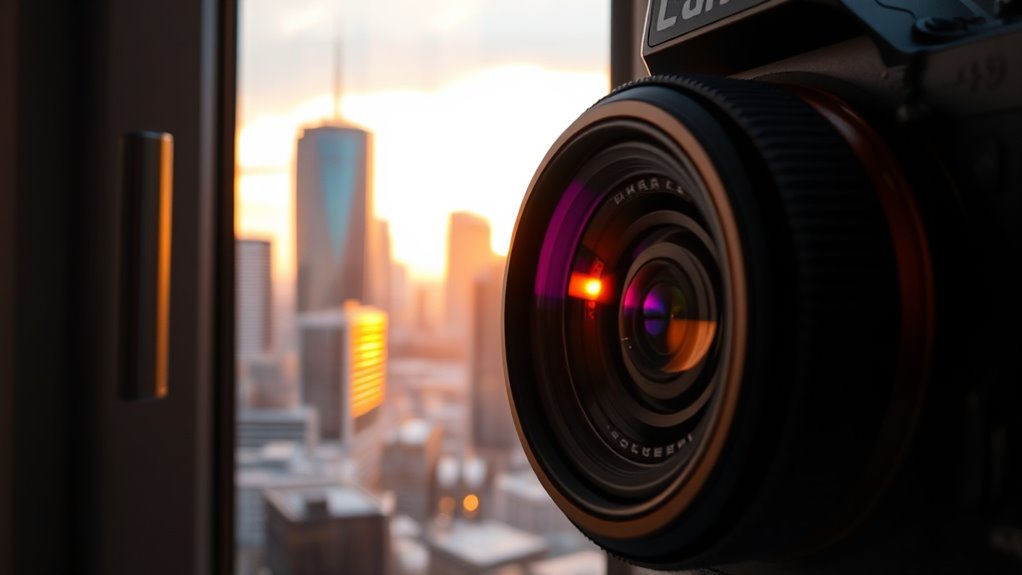
Dynamic iris technology enhances the flexibility and precision of exposure control in photography and videography, allowing you to adapt seamlessly to changing lighting conditions. By adjusting the aperture in real-time, you can prevent overexposure or underexposure, especially in scenes with high contrast. This technology helps reduce lens flare caused by bright light sources and supports image stabilization by maintaining consistent exposure during camera movements. In practical use, dynamic iris is valuable for capturing smooth, well-exposed footage without frequent manual adjustments. It’s especially beneficial in outdoor shoots or scenes with rapidly shifting light. This guarantees your images and videos stay sharp and evenly lit, even in challenging environments. Additionally, understanding cybersecurity vulnerabilities associated with camera equipment can help protect your devices from malicious attacks.
- Enhances automatic exposure in HDR photography
- Minimizes lens flare artifacts in bright conditions
- Supports smooth transitions during panning shots
- Reduces flickering in video recordings
- Allows for consistent exposure in variable lighting
Common Challenges and Limitations of Dynamic Iris Technology
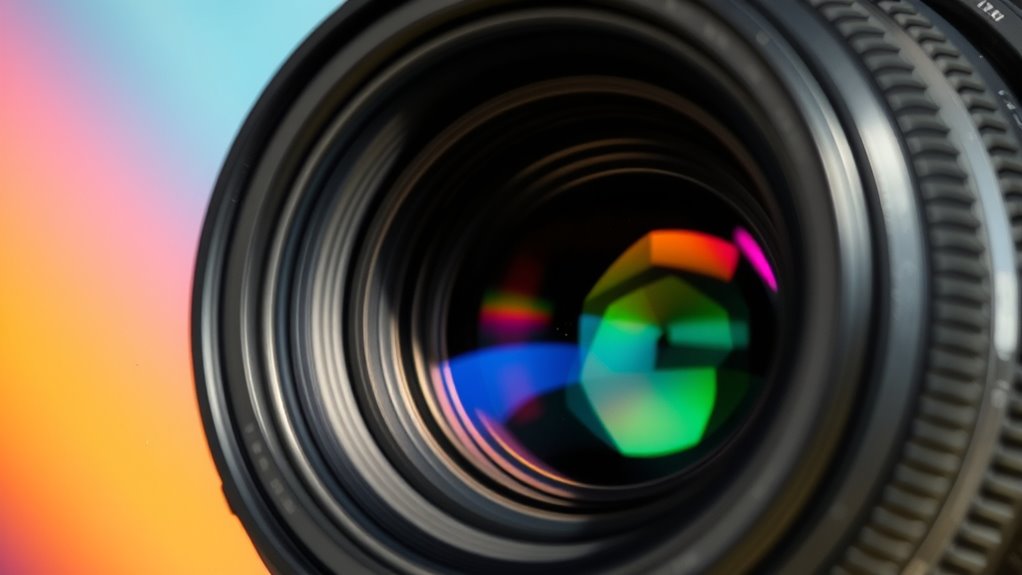
While dynamic iris technology offers significant benefits, it also presents several challenges that can impact its effectiveness. One common issue is lens flare, which can occur when the iris adjusts abruptly, causing unwanted reflections and reducing image clarity. Additionally, the technology can sometimes lead to color bleeding, especially in high-contrast scenes, where the iris struggles to balance exposure without compromising color accuracy. These limitations may result in inconsistent image quality and require manual adjustments or additional post-processing. Furthermore, rapid changes in lighting conditions can confuse the iris, causing flickering or delays in aperture adjustment. Proper calibration and understanding of the iris’s operating mechanism can help mitigate some of these issues and improve overall performance. Understanding these challenges helps you anticipate potential pitfalls and optimize your camera settings for better results.
Future Trends and Developments in Iris Control Systems
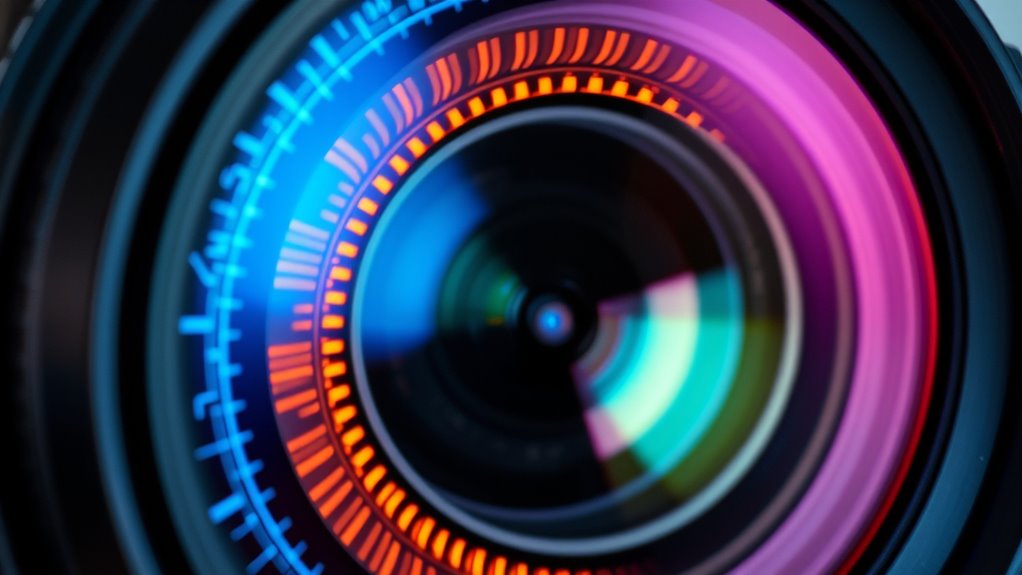
Future developments in iris control systems will likely include AI-driven color adaptation that adjusts to your environment seamlessly. You’ll also see increased integration with smart devices, making your iris technology more intuitive and connected. Additionally, enhanced user customization options will give you greater control over how the system responds to your preferences. As compatibility considerations become more sophisticated, systems may also incorporate astrological compatibility insights to tailor user experiences based on personal traits.
AI-Driven Color Adaptation
AI-driven color adaptation is set to revolutionize iris control systems by enabling real-time, personalized changes in eye color based on environmental cues and user preferences. Advanced algorithms analyze sensor sensitivity and adjust for lens distortion, ensuring seamless progressions even in varying lighting conditions. This technology can detect subtle shifts in surroundings, automatically modifying eye color to match mood or context. You’ll benefit from more natural, dynamic visuals that respond instantly to your environment. As systems become smarter, expect increased accuracy in color rendering, enhanced user customization, and smoother operation. These developments will make iris control more intuitive and adaptive, creating a personalized experience. To deepen your understanding, consider these aspects:
- real-time environmental analysis
- personalized color profiles
- adaptive response to ambient light
- improved sensor calibration techniques
- future integration possibilities
Integration With Smart Devices
As smart devices become more integrated into daily life, iris control systems are increasingly designed to connect seamlessly with them, opening new possibilities for personalized experiences. You’ll see smarter integration through enhanced sensor calibration, ensuring accurate iris detection regardless of lighting or environment. Manufacturers are also working on improved lens coatings to reduce glare and reflections, making device interaction smoother. This integration allows your device to automatically adjust iris settings based on your preferences, activity, or ambient conditions, without manual input. You’ll benefit from real-time adjustments that improve image quality and color accuracy. As a result, your smart device becomes more intuitive, providing a tailored experience that adapts effortlessly to your environment and needs.
Enhanced User Customization
Advancements in iris control systems are paving the way for highly personalized user experiences, allowing you to tailor settings precisely to your preferences. Future developments will enable more granular adjustments through enhanced user customization features. You might soon calibrate sensors more easily, enhancing sensor calibration for different environments. Lens coatings will be integrated to improve color accuracy and reduce glare, enhancing your control over color output. Custom profiles could be stored for specific tasks, ensuring consistent results. Additionally, intuitive interfaces will let you adjust iris settings dynamically, reflecting your unique needs. These innovations will make iris control systems more adaptable, giving you unprecedented command over color and brightness. Expect smarter, more responsive systems that learn from your preferences and adjust automatically for optimal performance.
Frequently Asked Questions
Can Dynamic Iris Technology Be Used With Smartphone Cameras?
Yes, you can use dynamic iris technology with smartphone cameras, but it depends on your phone’s limitations and lens compatibility. Most smartphones don’t have built-in dynamic iris, but some advanced models or external add-ons do. Check if your phone’s lens supports manual aperture adjustments or if an external lens with this feature is compatible. This way, you can take advantage of dynamic iris benefits for better control over exposure and image quality.
How Does Dynamic Iris Impact Battery Life in Cameras?
Dynamic iris designs diminish drain on your device by deftly directing demand, reducing battery consumption. They optimize power management by adjusting aperture size based on lighting, meaning your camera uses less energy during less demanding shots. While it may slightly increase processing, the overall impact is minimal, helping you prolong your device’s battery life. So, with dynamic iris, you get vibrant visuals without sacrificing your phone’s power.
Is Dynamic Iris Compatible With All Types of Lenses?
Dynamic iris is compatible with many lenses, but it’s not universal. You need to check lens compatibility because some lenses lack the necessary iris adjustment features. When the lens supports iris adjustment, the camera can automatically control the aperture to optimize exposure. Always verify your lens specifications to guarantee dynamic iris works smoothly, as using incompatible lenses may limit performance or prevent the feature from functioning altogether.
What Maintenance Is Required for Cameras With Dynamic Iris?
Oh, sure, maintaining your dynamic iris is a breeze—just ignore it! In reality, you should regularly check iris adjustment to guarantee ideal performance. Keep lenses compatible by avoiding forced fittings or incompatible models. Clean the iris mechanism gently to prevent dust buildup, and periodically inspect for wear or damage. Proper maintenance ensures your camera’s dynamic iris functions smoothly, maintaining excellent image quality without the hassle of unexpected issues.
Does Dynamic Iris Affect Autofocus Performance?
Dynamic iris technology can impact autofocus performance because the iris mechanism adjusts the aperture automatically, which may cause slight shifts in focus. This interaction can sometimes lead to minor autofocus delays, especially in changing lighting conditions. However, modern cameras are designed to minimize this effect, ensuring smooth autofocus operation. If you notice issues, check if your camera’s autofocus system compensates well for iris adjustments, or consider manual focus in challenging lighting.
Conclusion
Now that you understand how dynamic iris technology works, you can see how it truly shines in capturing perfect shots. It’s a game-changer that helps you stay ahead of challenging lighting conditions and enhances color accuracy. Don’t let the opportunity pass you by—embrace this innovation and keep your camera’s performance on point. With dynamic iris, you’re better equipped to handle any scene that comes your way, so don’t wait for the perfect shot; create it.
